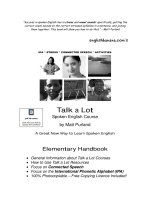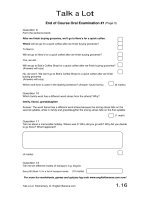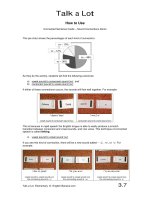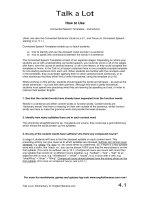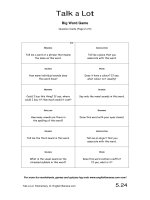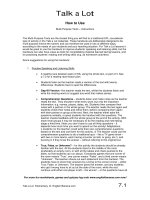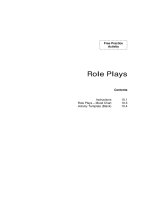Tài liệu Spoken english elementary handbook part 18 docx
Bạn đang xem bản rút gọn của tài liệu. Xem và tải ngay bản đầy đủ của tài liệu tại đây (168.35 KB, 15 trang )
Talk a Lot
Learn the International Phonetic Alphabet (IPA)
Spelling and Sounds – Consonant Clusters
For more fun worksheets, games and quizzes log onto www.englishbanana.com now!
Talk a Lot Elementary © English Banana.com
18.45
Verb: GO
Third Form: he goes, she goes, it goes
Can you imagine what would happen if we used LíL instead of LëL or LòL as a linking sound
in each of these situations? The consonant sound LíL is often dropped at the ends of words
(see p.11.5), because it is difficult to pronounce together with another consonant sound. If we
used it in the above rules instead of LëL or LòL (which connect well with all other consonant
sounds) the phrases produced would be much harder to say, because they wouldn’t flow
together well. For example, we would have to say: “John’t car”, instead of “John’s car”, which
would make a problem because the LíL sound at the end of “John’t” wouldn’t flow well with
the next consonant sound (the LâL sound at the beginning of “car”). Or what about “she’t
going”, instead of “she’s going”? Again, it would be much harder to pronounce. In fact the
result would be tongue-twisting on a massive scale! In the same way, having to pronounce
“he readt bookt”, instead of “he reads books” wouldn’t flow, because LíL – or indeed any
other consonant sound – wouldn’t enable the same easy flow that we achieve by using LëL or
LòL .
5. Consonant Clusters in Compound Words
In compound words, strange consonant clusters can occur, which are not “true” consonant
clusters. This is because two separate words have been joined together to make a new word,
meaning that the final consonant cluster from the first word has to sit side by side with the
initial consonant cluster from the second word. Here are some examples:
c/cluster: sounds like: for example: the two words are:
tchb LípÄL= = switchboard switch + board
ffh LÑÜL= = cliffhanger cliff + hanger
ndf LåÇÑL= = grandfather grand + father
ndbr LåÇÄêL= = groundbreaking ground + breaking
As we have seen, it is common when consonant sounds meet for elision or assimilation to
take place (see also Connected Speech, p.11.4). So, for example, we wouldn’t pronounce the
whole mouthful of consonant sounds in the middle of “groundbreaking”: LDÖê^råÇKÄêÉfKâfÏL ,
because it would be too difficult in rapid speech to pronounce the final consonant cluster “-nd”
next to the initial consonant cluster, “br”. On the contrary, we would automatically employ
elision and lose the LÇL sound, changing the word into: “groun-breaking” LDÖê^råKÄêÉfKâfÏL –
which is far easier to pronounce.
Talk a Lot
Learn the International Phonetic Alphabet (IPA)
Spelling and Sounds – Common Consonant Clusters
For more fun worksheets, games and quizzes log onto www.englishbanana.com now!
Talk a Lot Elementary © English Banana.com
18.46
A consonant cluster is a group of two or more consonant letters together in a word. They can be initial (at the
beginning of a word), medial (in the middle of a word), and final (at the end of a word). Focusing on consonant
clusters and vowel clusters (see p.18.48) is useful if you want to look at some of the differences between spelling and
sounds in English words. Consonant clusters can be divided into five categories:
1. Consonant Digraphs (two consonant letters together make a single sound) – INITIAL:
digraph: sounds like: for example: my example(s):
ch LípL= = cheer, champion, change ______________________
gn LåL= = gnat, gnaw, gnome ______________________=
kn LåL= = know, knife, knitting ______________________=
ph LÑL= = photo, pharmacy, pharaoh ______________________=
sc LëL= = science, scissors, scimitar ______________________=
sh LpL= = sheep, shine, shock, shed ______________________=
th LqL= = thick, Thursday, thanks ______________________=
th LaL= = this, that, brother, there, the ______________________
wh LïL= = what, why, where, wheel, whip ______________________=
wr LêL= = writing, wrestler, wrong ______________________=
FINAL:
digraph: sounds like: for example: my example(s):
ch LípL= = beach, coach, roach ______________________
ck LâL= = black, track, pick, flock, luck ______________________=
gh LÑL= = cough, trough, rough, enough, tough _________________=
mb LãL= = comb, tomb, aplomb, plumb ______________________=
ng LÏL= = along, going, eating, meeting ______________________=
sh LpL= = finish, trash, Spanish, fish ______________________=
th LqL= = tooth, youth, bath, path ______________________
2. Consonant Digraphs with Double Letters – MEDIAL:
digraph: sounds like: for example: my example(s):
bb LÄL= = robber, sobbing, hobble ______________________=
cc LâL= = soccer, occur, stucco ______________________
dd LÇL= = pudding, wedding, sadder ______________________
ll LäL= = alluring, allied, balloon ______________________=
mm LãL= = summer, humming, immature ______________________=
nn LåL= = runner, annoy, announcement ______________________=
pp LéL= = opportunity, shopping, kipper ______________________
rr LêL= = hurry, worried, curry, sorry ______________________=
ss LëL= = assess, less, massive ______________________=
tt LíL= = shutters, cottage, plotted ______________________=
Talk a Lot
Learn the International Phonetic Alphabet (IPA)
Spelling and Sounds – Common Consonant Clusters
For more fun worksheets, games and quizzes log onto www.englishbanana.com now!
Talk a Lot Elementary © English Banana.com
18.47
3. True Consonant Clusters (that sound the same as they are spelled) – INITIAL:
c/cluster: sounds like: for example: my example(s):
bl LÄäL= = blood, blend, black, blown ______________________=
br LÄêL= = bright, bring, brush, brilliant ______________________=
cr LâêL= = cry, crime, crow, crop, crumb ______________________=
dr LÇêL= = drink, drop, drive, drip, dreary ______________________=
fr LÑêL= = frighten, from, frame, France ______________________=
gr LÖêL= = great, grape, grip, grime, grow ______________________=
pr LéêL= = prove, provide, pray, princess ______________________=
qu LâïL= = quite, queen, quick, quiet ______________________=
ry LêáL= = dairy, eery, diary, hairy, bury ______________________=
scr LëâêL= = scream, script, scram, screw ______________________=
sm LëãL= = small, smart, smelly, smooth ______________________=
st LëíL= = stay, stop, stink, stolen, sty ______________________=
tr LíêL= = tropical, trench, train, triumph ______________________=
FINAL:
c/cluster: sounds like: for example: my example(s):
ly LäáL= = only, lonely, truly, rarely ______________________
mp LãéL= = hump, bump, clamp, damp ______________________=
nch LåípL= = munch, lunch, bench, stench ______________________
nd LåÇL= = end, stand, mend, ground ______________________
ndy LåÇáL= = windy, candy, handy, sandy ______________________=
4. Consonant Clusters Ending with LëL or LòL==(at the end of a plural noun) – FINAL:
c/cluster: sounds like: for example: my example(s):
nts LåíëL= = plants, accounts, rents ______________________=
rds LÇòL= = records, birds, cards, chords ______________________=
ts LíëL= = sweets, oats, boats ______________________
5. Consonant Clusters in Compound Words – (consonant clusters meet) – MEDIAL:
c/cluster: sounds like: for example: the two words are:
tchb LípÄL= = switchboard switch + board
ffh LÑÜL= = cliffhanger cliff + hanger
ndf LåÇÑL= = grandfather grand + father
ndbr LåÇÄêL= = groundbreaking ground + breaking
Talk a Lot
Learn the International Phonetic Alphabet (IPA)
Spelling and Sounds – Vowel Clusters
For more fun worksheets, games and quizzes log onto www.englishbanana.com now!
Talk a Lot Elementary © English Banana.com
18.48
A vowel cluster is a group of two or more vowel letters together in a word that represent a
single vowel sound. For example, in the word “road”, “oa” is a vowel cluster that represents
the sound L]rL , whilst in the word “shoe”, “oe” is a vowel cluster that represents the sound
LìWL. In the same way, “ar” in the word “car”, is a vowel cluster that uses a silent “r” to help
make the vowel sound L^WL. The reason we have vowel clusters is simple: there are 23
different single vowel sounds (vowel phonemes) in spoken English, but only 5 single vowel
letters in written English. We need vowel clusters to represent in spelling all of the different
vowel sounds. For example, the letter “a” on its own can make the sound LôL when
sandwiched between two consonant sounds, for example in the word “cat” – LâôíL – but there
is no single letter which can make the very common vowel sound =LìWL, as in “true” LíêìWL. We
have to use a vowel cluster – in this case “ue” – to represent this sound on paper.
Vowel clusters can occur anywhere in a word – at the beginning (initial), as in “out”; in the
middle (medial), as in “please”; and at the end (final), as in “true”. Focusing on vowel clusters
and consonant clusters (see p.18.39) is useful if you want to look at some of the differences
between spelling and sounds in English words. (See also Rhyming Words, pp.18.19-18.28.)
Vowel clusters can be divided into eight categories:
1. Vowel Digraphs
2. Vowel Trigraphs and Quadgraphs
3. Vowel Clusters that end with “-r”
4. Other Vowel Clusters with “r”
5. Vowel Clusters with “w”
6. Vowel Clusters with “y”
7. Vowel Clusters with “gh”
8. Vowel Clusters with Other Consonant Letters
What follows is a comprehensive list of vowel clusters, with the sounds that they represent,
grouped by letter in alphabetical order. (Note: you may wish to add your own examples in the
space provided.)
1. Vowel Digraphs
Vowel digraphs are two vowel letters together in the spelling of a word that represent a single
sound (one vowel phoneme). For example, in the word “meat”, “ea” is a vowel digraph that
represents the sound LáWL , whilst in the word “meet”, “ee” is a vowel digraph that also stands
for the same vowel sound: LáWL . This kind of thing can lead to a lot of confusion between
spelling and sounds in English!
digraph: sounds like: for example: my example(s):
ai LÉfL= = paid, wait, fail, paint, gain ______________________
ai LÉL= = said, again ______________________
au LlWL= = fraud, pause, autumn, August ______________________
Talk a Lot
Learn the International Phonetic Alphabet (IPA)
Spelling and Sounds – Vowel Clusters
For more fun worksheets, games and quizzes log onto www.englishbanana.com now!
Talk a Lot Elementary © English Banana.com
18.49
au L^WL= = laugh, laughter ______________________
ea LÉfL= = break, steak, great ______________________
ea LáWL= = read, appeal, lead, clean, leaf, steal __________________
ea LÉL= = read, bread, dreampt, dead, dread ___________________
ee LáWL= = wheel, peel, kneel, heel ______________________
ei LáWL= = receive, deceive, receipt ______________________
ei LÉfL= = rein, vein ______________________
eo LÉL= = leopard, Leonard ______________________
eu LlfL= = Freud ______________________
ia L~f]L= = vial ______________________
ie L~fL= = tie, die, lie, pie ______________________
ie Lf]L= = field, yield, wield ______________________
ie LáWL= = activities, believe, achieve ______________________
ie L~f]L= = variety ______________________
io L]L= = station, completion, ration ______________________
iu /f]L= = valium, tedium, radium ______________________
oa L]rL= = oak, foam, loaf, encroach, road ______________________
oa LlWL= = broad, abroad ______________________
oe LìWL= = shoe ______________________
oe L]rL= = toe,=hoe, woe, foe, goes ______________________
oe L¾L= = does, doesn’t ______________________
oi LlfL= = avoid, void, coin, toilet ______________________
oo LìWL= = school, tool, fool, choose ______________________
oo LrL= = good, book, took, rook, hood ______________________
oo L¾L= = blood, flood ______________________
oo L]rL= = brooch ______________________
ou L~rL= = sound, loud, proud, round, house ____________________
ou LìWL= = route, you, soup, group ______________________
Talk a Lot
Learn the International Phonetic Alphabet (IPA)
Spelling and Sounds – Vowel Clusters
For more fun worksheets, games and quizzes log onto www.englishbanana.com now!
Talk a Lot Elementary © English Banana.com
18.50
ou L]L= = famous, jealous, onerous ______________________
ou LflL= = cough, trough ______________________
ou L¾L= = rough, enough, tough ______________________
ue LìWL= = blue, true, sue ______________________
ue LÉL= = guess, guest ______________________
ue Lr]L= = fuel, puerile, duel ______________________
ui L~fL= = guide, guidance ______________________
ui LìWL= = juice, bruise ______________________
ui LfL= = build, building, guilt ______________________
Most of the vowel sounds of English (18 out of 23) are represented by these 18 different
vowel digraphs. The sounds not represented are: LôL, LáL, L‰WL, LÉ]L, L~r]L . The last three
sounds are represented by vowel clusters that use “r” (see below).
2. Vowel Trigraphs and Quadgraphs
It is possible, though fairly uncommon, to find more than two vowel letters together in an
English word. A group of three letters that make a single sound is called a trigraph. For
example:
trigraph: sounds like: for example: my example(s):
eau L]rL= = beau, eau de toilette
1
______________________
eou L]L= = outrageous, contageous ______________________
iou Lf]L= = industrious, harmonious, tedious ____________________
A group of four letters that makes a single sound is called a quadgraph. For example:
quadgraph: sounds like: for example: my example(s):
ueue LìWL= = queue ______________________
3. Vowel Clusters that End with “-r”
The “r” in the spelling helps to make the single vowel sound. Note: the consonant sound LêL
is not pronounced.
1
in loan words from French
